The Impact of Additives on Gaseous Pollutants from the Combustion of Various Solid Fuels
Abstract
:1. Introduction
2. Materials and Methods
2.1. Feedstock for Combustion Processes
2.2. Characteristics of Selected Solid Fuels
2.3. Fuel Additives
2.4. Combustion Process
2.5. Exhaust Composition Measurements
- Zs1—the actual content of the chemical compound in the exhaust gas [%, mg/m3];
- Zs2—the content of a chemical compound in the flue gas for a given oxygen content [%, mg/m3];
- O2′—the set oxygen content in the exhaust gas [%];
- O2″—the actual oxygen content in the exhaust gas [%].
- λ—the excess air coefficient;
- O2″—the actual oxygen content in the exhaust gas [%].
3. Results and Discussion
3.1. Analysis of the Elemental Composition of Selected Fuels
3.2. Analysis of the Elemental Composition of Combustion Additives
3.3. Emission of Gaseous Components
4. Conclusions
Author Contributions
Funding
Data Availability Statement
Conflicts of Interest
References
- Dadario, N.; Gabriel Filho, L.R.A.; Cremasco, C.P.; Santos, F.A.d.; Rizk, M.C.; Mollo Neto, M. Waste-to-Energy Recovery from Municipal Solid Waste: Global Scenario and Prospects of Mass Burning Technology in Brazil. Sustainability 2023, 15, 5397. [Google Scholar] [CrossRef]
- Ali, M.U.; Yu, Y.; Yousaf, B.; Munir, M.A.M.; Ullah, S.; Zheng, C.; Kuang, X.; Wong, H.M. Health impacts of indoor air pollution from household solid fuel on children and women. J. Hazard. Mater. 2021, 416, 126127. [Google Scholar] [CrossRef]
- Kaya, D.; Çanka Kılıç, F.; Öztürk, H.H. Fuels and Combustion. In Energy Management and Energy Efficiency in Industry. Green Energy and Technology; Springer: Cham, Switzerland, 2021. [Google Scholar]
- Du, W.; Shen, G.; Chen, Y.; Zhu, X.; Zhuo, S.; Zhong, Q.; Qi, M.; Xue, C.; Liu, G.; Zeng, E.; et al. Comparison of air pollutant emissions and household air quality in rural homes using improved wood and coal stoves. Atmos. Environ. 2017, 166, 215–223. [Google Scholar] [CrossRef]
- Chen, Y.; Shen, G.; Liu, W.; Du, W.; Su, S.; Duan, Y.; Lin, N.; Zhuo, S.; Wang, X.; Xing, B.; et al. Field measurement and estimate of gaseous and particle pollutant emissions from cooking and space heating processes in rural households, northern China. Atmos. Environ. 2016, 125, 265–271. [Google Scholar] [CrossRef]
- Chyc, M.; Burzała, B. Carbon black—Hazardous waste. Waste Manag. Environ. Prot. Arch. 2012, 14, 65–70. (In Polish) [Google Scholar]
- Chyc, M.; Wielgus, Ż.; Helios-Rybicka, E.; Latowski, D. The influence of combustion method in a low-power boiler on the content of PAHs and radicals in soot. Contemp. Energy Probl. 2015, 1, 19–26. (In Polish) [Google Scholar]
- Wang, L.; Hustada, J.E.; Skreiberg, Ø.; Skjevraka, G.; Grønlia, M. A critical review on additives to reduce ash related operation problems in biomass combustion applications. Energy Procedia 2012, 20, 20–29. [Google Scholar] [CrossRef]
- Tobiasen, L.; Skytte, R.; Pedersen, L.S.; Pedersen, S.T.; Lindberg, M.A. Deposit characteristic after injection of additives to a Danish straw-fired suspension boiler. Fuel Process. Technol. 2007, 88, 1108–1117. [Google Scholar] [CrossRef]
- Broström, M.; Kassman, H.; Helgesson, A.; Berg, M.; Andersson, C.; Backman, R.; Nordin, A. Sulfation of corrosive alkali chlorides by ammonium sulfate in a biomass fired CFB boiler. Fuel Process. Technol. 2007, 88, 1171–1177. [Google Scholar] [CrossRef]
- Pettersson, A.; Amand, L.-E.; Steenari, B.-M. Chemical fractionation for the characterization of fly ashes from combustion of biofuels using different methods for alkali reduction. Fuel 2009, 88, 1758–1772. [Google Scholar] [CrossRef]
- Szatyłowicz, E.; Skoczko, I. Evaluation of the PAH Content in Soot from Solid Fuels Combustion in Low Power Boilers. Energies 2019, 12, 4254. [Google Scholar] [CrossRef]
- Szatyłowicz, E.; Walendziuk, W. Analysis of Polycyclic Aromatic Hydrocarbon Content in Ash from Solid Fuel Combustion in Low-Power Boilers. Energies 2021, 14, 6801. [Google Scholar] [CrossRef]
- Gonzalez, J.F.; Gonzalez-Garca, C.M.; Ramiro, A.; Gonzalez, J.; Sabio, E.; Ganan, J.; Rodrguez, M.A. Combustion optimisation of biomass residue pellets for domestic heating with a mural boiler. Biomass Bioenergy 2004, 27, 145–154. [Google Scholar] [CrossRef]
- Dołżyńska, M.; Obidziński, S.; Kowczyk-Sadowy, M.; Krasowska, M. Densification and Combustion of Cherry Stones. Energies 2019, 12, 3042. [Google Scholar] [CrossRef]
- Kułażyński, M.; Kaczmarczyk, J.; Świątek, Ł.; Pstrowska, K.; Jabłoński, S.; Łukaszewicz, M. Technological problems occurring during the implementation of the co-combustion process of brown coal with biomass. Logistics 2015, 5, 277–282. (In Polish) [Google Scholar]
- Obernberger, I.; Brunner, T.; Barnthaler, G. Chemical properties of solid biofuels—Significance and impact. Biomass Bioenergy 2006, 30, 973–982. [Google Scholar] [CrossRef]
- Hardy, T.; Kordylewski, W.; Mościcki, K. Chloride corrosion hazard resulting from biomass combustion and co-combustion in boilers. Combust. Arch. 2009, 9, 181–195. (In Polish) [Google Scholar]
- Jelonek, I.; Jelonek, Z. Fuel quality assessment on the example of bituminous coal and wooden pellets. Opencast Min. 2018, 59, 69–77. (In Polish) [Google Scholar]
- Miranda, I.; Gominho, J.; Mirra, I.; Pereira, H. Chemical characterization of barks from Picea abies and Pinus sylvestris after fractioning into different particle sizes. Ind. Crops Prod. 2012, 36, 395–400. [Google Scholar] [CrossRef]
- Nussbaumer, T. Combustion and co-combustion of biomass. Energy Fuels 2003, 17, 1510–1521. [Google Scholar] [CrossRef]
- Glarborg, P.; Miller, J.A.; Ruscic, B.; Klippenstein, S.J. Modeling nitrogen chemistry in combustion. Prog. Energy Combust. Sci. 2018, 67, 31–68. [Google Scholar] [CrossRef]
- Glarborg, P. Hidden interactions—Trace species governing combustion and emissions. Proc. Combust. Inst. 2007, 31, 77–98. [Google Scholar] [CrossRef]
- Glarborg, P.; Jensen, A.D.; Johnsson, J.E. Fuel nitrogen conversion in solid fuel fired systems. Prog. Energy Combust. Sci. 2003, 29, 89–113. [Google Scholar] [CrossRef]
- Janicki, M. The concentration of elementary pollution in exhaust gases during combustion of pellets, made of virginia and wood, in low-power boiler. Arch. Waste Manag. Environ. Prot. 2014, 16, 103–112. [Google Scholar]
- Aho, M.; Ferre, E. Importance of coal ash composition in protecting the boiler against chlorine deposition during combustion of chlorine-rich biomass. Fuel 2005, 84, 201–212. [Google Scholar] [CrossRef]
- Micek, E.; Patyna, I.; Skawińska, A. The influence of sulfur and chlorine content in coal on the corrosion phenomenon in combustion processes. Min. Rev. 2013, 69, 93–99. (In Polish) [Google Scholar]
- Khan, A.A.; de Jong, W.; Jansens, P.J.; Spliethoff, H. Biomass combustion in fluidized bed boilers: Potential problems and remedies. Fuel Process. Technol. 2009, 90, 21–50. [Google Scholar] [CrossRef]
- Wasielewski, R.; Hrabak, J. Influence of chlorine, sulfur and alkalis content in waste biomass on its use in power production. Arch. Waste Manag. Environ. Prot. 2019, 17, 1–8. [Google Scholar]
- Ren, X.; Sun, R.; Chi, H.-H.; Meng, X.; Li, Y.; Levendis, Y.A. Hydrogen chloride emissions from combustion of raw and torrefied biomass. Fuel 2017, 200, 37–46. [Google Scholar] [CrossRef]
- Yanik, J.; Duman, G.; Karlström, O.; Brink, A. NO and SO2 emissions from combustion of raw and torrefied biomasses and their blends with lignite. J. Environ. Manag. 2018, 227, 155–161. [Google Scholar] [CrossRef]
- Król, D.J. Biomasa i Paliwa Formowane z Odpadów w Niskoemisyjnych Technologiach Spalania; Monografia; Wydawnictwo Politechniki Śląskiej: Gliwice, Poland, 2013. (In Polish) [Google Scholar]
- Li, X.G.; Ma, B.G.; Xu, L.; Luo, Z.T.; Wang, K. Catalytic effect of metallic oxides on combustion behavior of high ash coal. Energy Fuels 2007, 21, 2669–2672. [Google Scholar] [CrossRef]
- Gong, X.; Guo, Z.; Wang, Z. Reactivity of pulverized coals during combustion catalyzed by CeO2 and Fe2O3. Combust. Flame 2010, 157, 351–356. [Google Scholar] [CrossRef]
- Gong, X.; Guo, Z.; Wang, Z. Variation on anthracite combustion efficiency with CeO2 and Fe2O3 addition by differential thermal analysis (DTA). Energy 2010, 35, 506–511. [Google Scholar] [CrossRef]
- Chavda, R.; Mahanwar, P. Effect of inorganic and organic additives on coal combustion: A review. Int. J. Coal Prep. Util. 2018, 41, 749–766. [Google Scholar] [CrossRef]
- Fangxian, L.; Shizong, L.; Youzhi, C. Thermal analysis study of the effect of coal-burning additives on the combustion of coals. J. Therm. Anal. Calorim. 2009, 95, 633–638. [Google Scholar] [CrossRef]
- He, X.-M.; Qin, J.; Liu, R.-Z.; Hu, Z.-J.; Wang, J.-G.; Huang, C.-J.; Li, T.-L.; Wang, S.-J. Catalytic combustion of inferior coal in the cement industry by thermogravimetric analysis. Energy Sources Part A Recovery Util. Environ. Eff. 2013, 35, 1233–1240. [Google Scholar] [CrossRef]
- Kim, Y.-K.; Hao, L.-F.; Park, J.-I.; Miyawaki, J.; Mochida, I.; Yoon, S.-H. Catalytic activity and activation mechanism of potassium carbonate supported on perovskite oxide for coal char combustion. Fuel 2012, 94, 516–522. [Google Scholar] [CrossRef]
- Yin, K.; Zhou, Y.-M.; Yao, Q.-Z.; Fang, C.; Zhang, Z.-W. Thermogravimetric analysis of the catalytic effect of metallic compounds on the combustion behaviors of coals. React. Kinet. Mech. Catal. 2012, 106, 369–377. [Google Scholar] [CrossRef]
- Shen, B.; Qinle. Study on MSW catalytic combustion by TGA. Energy Convers. Manag. 2006, 47, 1429–1437. [Google Scholar] [CrossRef]
- Li, C.; Suzuki, K. Kinetics of perovskite catalyzed biomass tar combustion studied by thermogravimetry and differential thermal analysis. Energy Fuels 2009, 23, 2364–2369. [Google Scholar] [CrossRef]
- Zhang, L.-M.; Tan, Z.-C.; Wang, S.-D.; Wu, D.-Y. Combustion calorimetric and thermogravimetric studies of graphite and coals doped with a coal-burning additive. Thermochim. Acta 1997, 299, 13–17. [Google Scholar] [CrossRef]
- Sahu, S.; Mukherjee, A.; Kumar, M.; Adak, A.; Sarkar, P.; Biswas, S.; Tiwari, H.; Das, A.; Banerjee, P. Evaluation of combustion behaviour of coal blends for use in pulverized coal injection (PCI). Appl. Therm. Eng. 2014, 73, 1014–1021. [Google Scholar] [CrossRef]
- Zou, C.; Wen, L.; Zhang, S.; Bai, C.; Yin, G. Evaluation of catalytic combustion of pulverized coal for use in pulverized coal injection (PCI) and its influence on properties of unburnt chars. Fuel Process. Technol. 2014, 119, 136–145. [Google Scholar] [CrossRef]
- Wenqing, L.; Wang, L.; Qiao, Y.; Lin, J.Y.; Wang, M.; Chang, L. Effect of atmosphere on the release behavior of alkali and alkaline earth metals during coal oxy-fuel combustion. Fuel 2015, 139, 164–170. [Google Scholar]
- Doggali, P.; Kusaba, H.; Einaga, H.; Bensaid, S.; Rayalu, S.; Teraoka, Y.; Labhsetwar, N. Low cost catalysts for the control of Indoor CO and PM emissions from solid fuel combustion. J. Hazard. Mater. 2011, 186, 796–804. [Google Scholar] [CrossRef]
- Sowa, J.M.; Fletcher, T.H. Investigation of an iron-based additive on coal pyrolysis and char oxidation at high heating rates. Fuel Process. Technol. 2011, 92, 2211–2218. [Google Scholar] [CrossRef]
- Rokni, E.; Ren, X.; Panahi, A.; Levendis, Y.A. Emissions of SO2, NOx, CO2, and HCl from Co-firing of coals with raw and torrefied biomass fuels. Fuel 2018, 211, 363–374. [Google Scholar] [CrossRef]
- Wandrasz, J.W.; Wandrasz, A.J. Paliwa Formowane Biopaliwa i Paliwa z Odpadów w Procesach Termicznych; Wydaw; Seidel-Przywecki: Warsaw, Poland, 2006. (In Polish) [Google Scholar]
- Szyszlak-Bargłowicz, J.; Zając, G.; Słowik, T. Study of selected gaseous pollutants emission during combustion of agro-biomass pellets in a low-power boiler. Environ. Prot. Yearb. 2017, 19, 715–730. (In Polish) [Google Scholar]
- Ciupek, B.; Janeba-Bartoszewicz, R.; Urbaniak, R. Wpływ rozdrobnienia i zwiększonej wilgotności paliw węglowych na skład chemiczny spalin. Przemysł Chem. 2019, 98, 1283–1285. (In Polish) [Google Scholar] [CrossRef]
- Mustafa, B.G.; Kiah, M.H.M.; Irshad, A.; Andrews, G.E.; Phylaktou, H.N.; Li, H.; Gibbs, B.M. Rich biomass combustion: Gaseous and particle number emissions. Fuel 2019, 248, 221–231. [Google Scholar] [CrossRef]
- Marynowski, L.; Kubik, R.; Uhl, D.; Simoneit, B.R.T. Molecular composition of fossil charcoal and relationship with incomplete combustion of wood. Org. Geochem. 2014, 77, 22–31. [Google Scholar] [CrossRef]
- Ravichandran, P.; Corscadden, K. Comparison of gaseous and particle emissions produced from leached and un-leached agricultural biomass briquettes. Fuel Process. Technol. 2014, 128, 359–366. [Google Scholar] [CrossRef]
- Yang, B.; Peng, L.; Wang, Y.; Song, J. The characteristics of air pollutants from the combustion of biomass pellets. Energy Sources Part A Recovery Util. Environ. Eff. 2018, 40, 351–357. [Google Scholar] [CrossRef]
- Kumal, K.; Mikuska, P.; Horak, J.; Hopan, F.; Krpec, K. Comparison of emissions of gaseous and particulate pollutants from the combustion of biomass and coal in modern and old-type boilers used for residential heating in the Czech Republic, Central Europe. Chemosphere 2019, 229, 51–59. [Google Scholar] [CrossRef] [PubMed]
- Wielgosiński, G.; Łechtańska, P.; Namiecińska, O. Emission of some pollutants from biomass combustion in comparison to hard coal combustion. J. Energy Inst. 2017, 90, 787–796. [Google Scholar] [CrossRef]
- Williams, A.; Jones, J.M.; Ma, L.; Pourkashanian, M. Pollutants from the combustion of solid biomass fuels. Prog. Energy Combust. Sci. 2012, 38, 113–137. [Google Scholar] [CrossRef]
- Dołżyńska, M.; Obidziński, S. Effect of used cooking oil additive on sewage sludge combustion. Przemysł Chem. 2017, 96, 1848–1851. [Google Scholar]
- Shao, K.; Li, X.; Wei, Y.; Liu, J. Correlation between PCDD/F, PCB and PCBz formed by de novo synthesis. Adv. Mater. Res. 2012, 356–360, 998. [Google Scholar] [CrossRef]
- Tic, W.J.; Guziałowska-Tic, J. The Effect of Modifiers and Method of Application on Fine-Coal Combustion. Energies 2019, 12, 4572. [Google Scholar] [CrossRef]
- Tic, W.J.; Guziałowska-Tic, J.; Junga, R. The impact of catalytic additive for coal fuel on the environmental emissions. Przemysł Chem. 2015, 94, 1000–1003. [Google Scholar]
- Yu, S.; Xie, F.; Jia, B.; Zhang, P. Influence Study of Organic and Inorganic Additive to Coal Combustion, Characteristic. Procedia Environ. Sci. 2012, 12, 459–467. [Google Scholar]
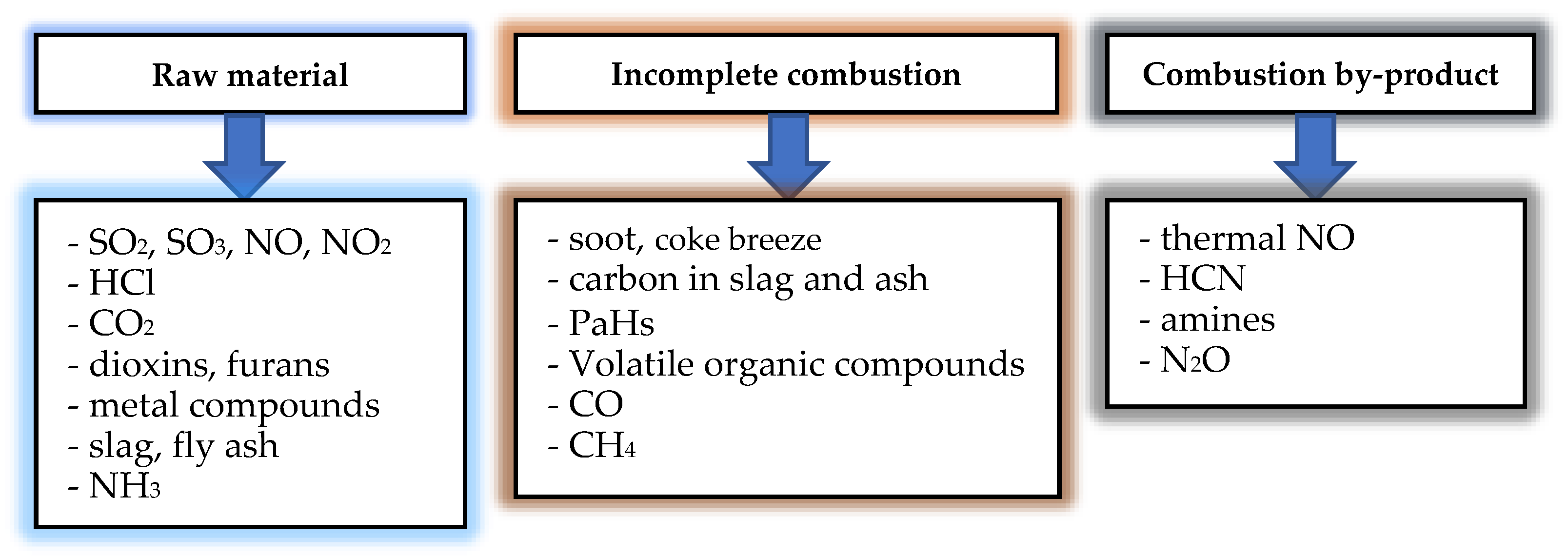
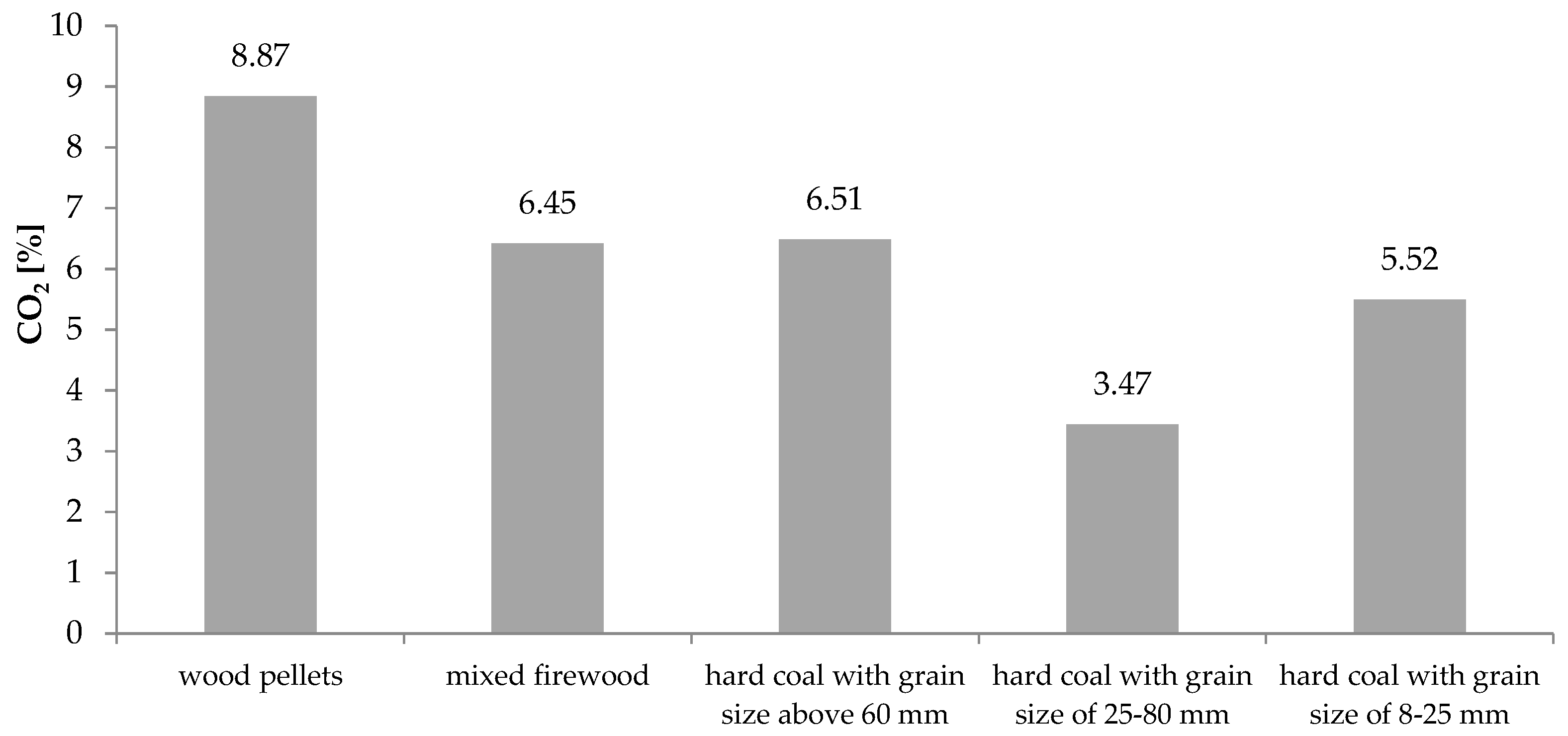

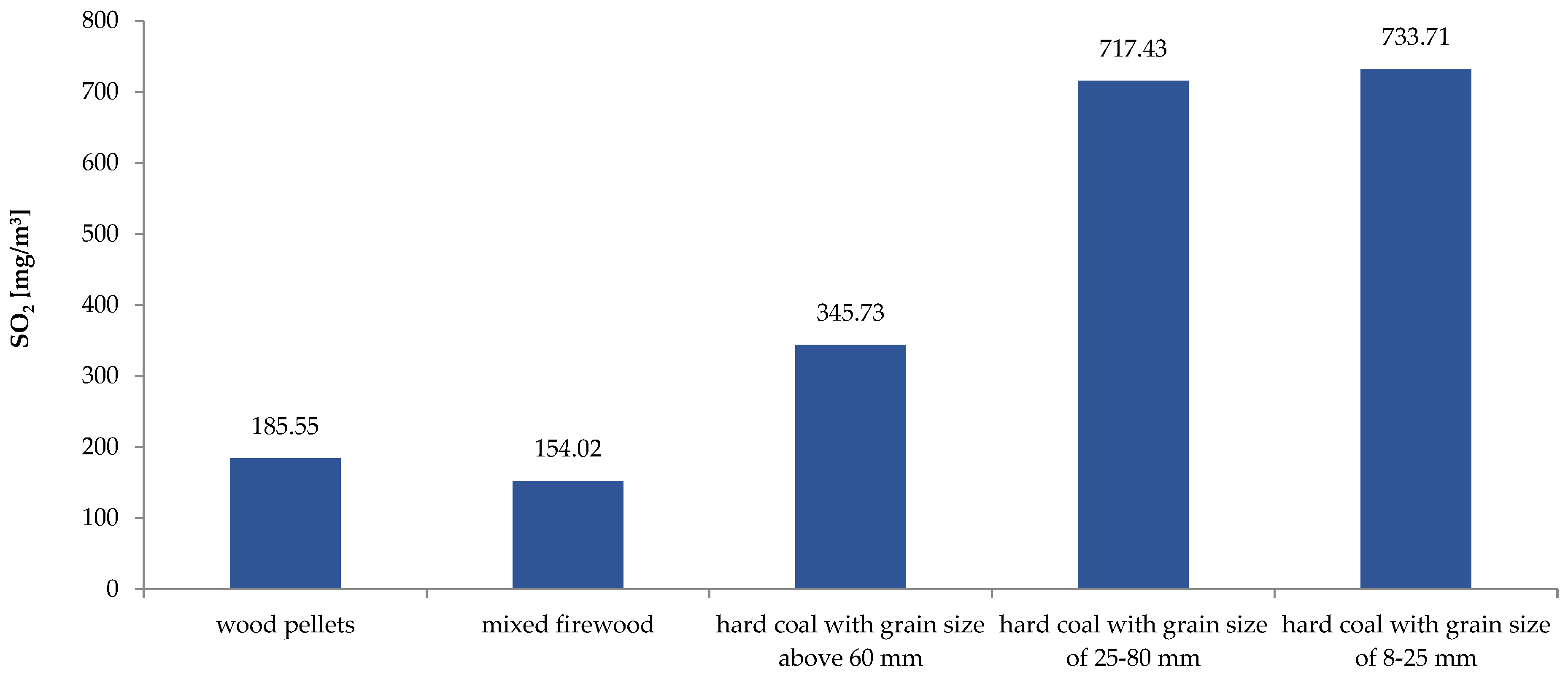


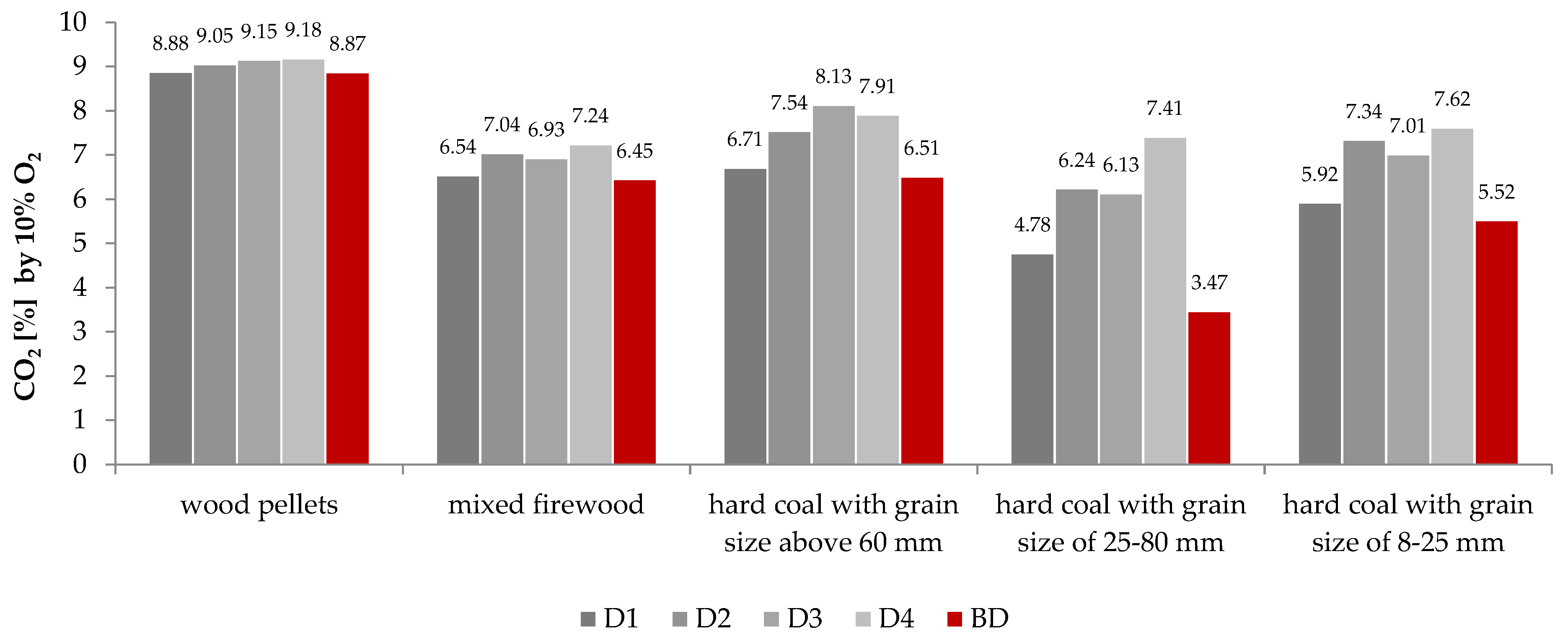



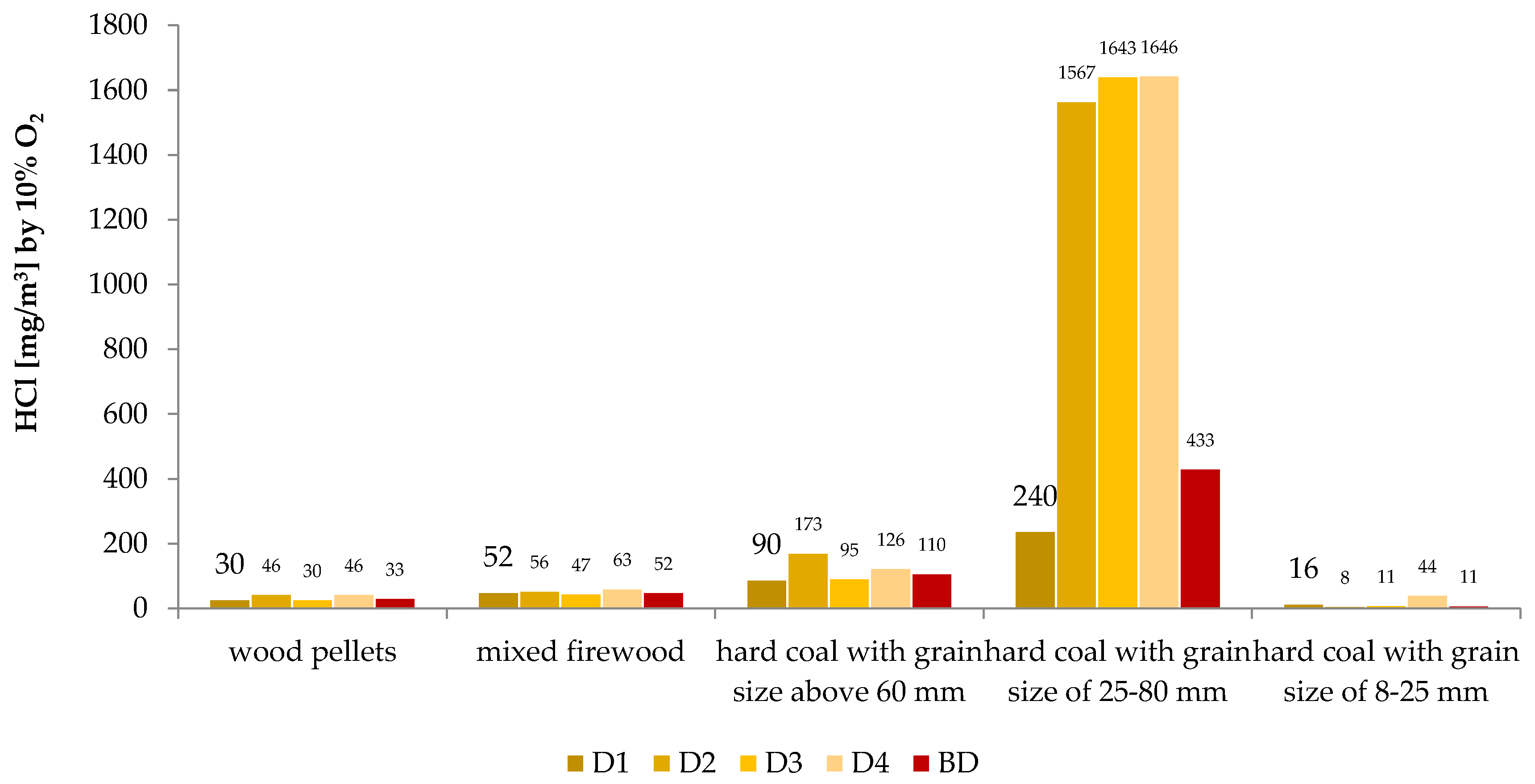
| Type of Fuel | Granulation [mm] | Calorific Value [MJ/kg] | Moisture [%] | Volatile Content [%] | Ash Content [%] | Total Sulfur Content [%] |
|---|---|---|---|---|---|---|
| hard coal with a grain size above 60 mm | 60–200 | 23–25 | <19 | >35 | Max 7 | Max 0.5 |
| hard coal with a granulation of 25–80 mm | 25–80 | 26 | 9 | no data | 5 | 0.6 |
| hard coal with a granulation of 8–25 mm | 8–25 | 26 | 0–15 | no data | 0–10 | 0–0.08 |
| wood pellets | 6 | 18 | 6.6–8.8 | no data | 0.8–1.1 | 0.01 |
| mixed firewood | 100–300 | 15 | 12 | no data | 0.4 | no data |
| Solid Fuels | Carbon | Hydrogen | Sulfur | Nitrogen | Oxygen * | Chlorine | ||
|---|---|---|---|---|---|---|---|---|
| [%] in Working Condition | ||||||||
| mixed firewood | tree bark | 49.50 ± 0.20 | 5.58 ± 0.003 | 0.455 | 0.84 ± 0.06 | 43.60 | 0.034 | |
| middle | 50.81 ± 0.12 | 6.11 ± 0.03 | 0.461 | 0.14 ± 0.08 | 42.41 | 0.019 | ||
| pellets | 51.54 ± 0.06 | 6.28 ± 0.01 | 0.441 | 0.05 ± 0.01 | 41.70 | 0.008 | ||
| hard coal with a granulation of 8–25 m | 68.38 ± 0.44 | 5.02 ± 0.06 | 0.502 | 0.65 ± 0.06 | 25.44 | 0.015 | ||
| hard coal with a granulation of 25–80 mm | 72.44 ± 0.17 | 5.81 ± 0.10 | 0.569 | 0.79 ± 0.06 | 20.04 | 0.012 | ||
| hard coal with a grain size above 60 mm | 69.05 ± 0.17 | 4.59 ± 0.03 | 0.902 | 0.69 ± 0.08 | 25.10 | 0.014 | ||
| Element/Number of Additives | D1 | D2 Content% | D3 | D4 |
|---|---|---|---|---|
| Al | 0.97 | - | - | - |
| C | 9.48 | 0.71 | 0.95 | 0.58 |
| Ca | 18.98 | - | 4.15 | - |
| Cl | - | 26.73 | 32.03 | 37.52 |
| Cr | - | - | - | 0.12 |
| Cu | - | 0.30 | 12.96 | 0.23 |
| Fe | 0.46 | 0.54 | 0.20 | 0.59 |
| K | 2.80 | 20.80 | 0.50 | 0.07 |
| Mg | 10.14 | 8.1 | - | - |
| N | - | 10.48 | 2.22 | 5.09 |
| Na | 12.84 | 18.18 | 17.35 | 24.18 |
| P | 1.07 | 0.68 | - | - |
| S | 0.86 | 10.61 | 5.58 | 26.11 |
| Si | 4.72 | - | 1.99 | - |
| Zn | - | - | - | 3.15 |
Disclaimer/Publisher’s Note: The statements, opinions and data contained in all publications are solely those of the individual author(s) and contributor(s) and not of MDPI and/or the editor(s). MDPI and/or the editor(s) disclaim responsibility for any injury to people or property resulting from any ideas, methods, instructions or products referred to in the content. |
© 2024 by the authors. Licensee MDPI, Basel, Switzerland. This article is an open access article distributed under the terms and conditions of the Creative Commons Attribution (CC BY) license (https://creativecommons.org/licenses/by/4.0/).
Share and Cite
Szatyłowicz, E.; Siemieniuk, A. The Impact of Additives on Gaseous Pollutants from the Combustion of Various Solid Fuels. Energies 2024, 17, 3876. https://doi.org/10.3390/en17163876
Szatyłowicz E, Siemieniuk A. The Impact of Additives on Gaseous Pollutants from the Combustion of Various Solid Fuels. Energies. 2024; 17(16):3876. https://doi.org/10.3390/en17163876
Chicago/Turabian StyleSzatyłowicz, Ewa, and Anna Siemieniuk. 2024. "The Impact of Additives on Gaseous Pollutants from the Combustion of Various Solid Fuels" Energies 17, no. 16: 3876. https://doi.org/10.3390/en17163876
APA StyleSzatyłowicz, E., & Siemieniuk, A. (2024). The Impact of Additives on Gaseous Pollutants from the Combustion of Various Solid Fuels. Energies, 17(16), 3876. https://doi.org/10.3390/en17163876








